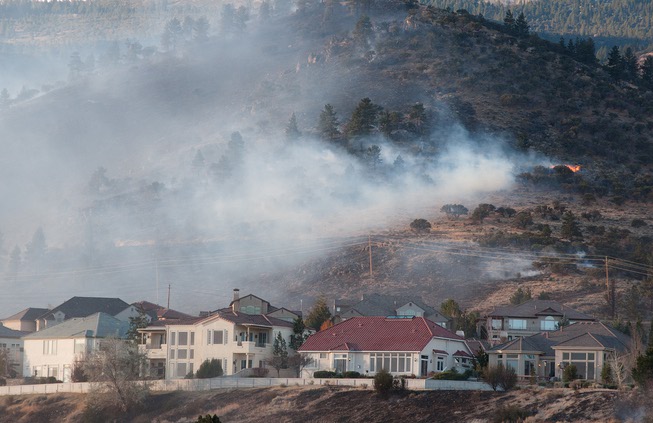
Kevin Clifford / AP file (2011)
The 400-acre Caughlin Fire burns near homes Nov. 18, 2011, in Reno. The fire chased Jamie Royce-Gomes from her apartment. A dozen years later, Royce-Gomes is the manager of the Living With Fire program at the UNR Extension, which provides recommendations on preparing for wildfires and reducing wildfire threats to homes and communities.
Friday, June 2, 2023 | 2 a.m.
Wildfires in Nevada
Jamie Royce-Gomes woke up at 2 a.m. to an apartment full of smoke, no electricity and no idea how close the flames were from the Caughlin Fire.
Royce-Gomes was always vigilant about avoiding smoke because it could be a trigger for her asthma, but assumed her urban Reno apartment was far from the rural blaze in southwest Reno on Nov. 18, 2011. But the fire moved quickly and spread through Steamboat Ditch, the canyon behind her building.
“I thought I’d be OK,” said Royce-Gomes, who now directs the Living With Fire program at UNR, her alma mater. “It wasn’t until I couldn’t breathe that it became apparent.”
She rushed out of the apartment to evacuate with her roommate, remembering the panic in the streets as neighbors were also leaving their homes under an orange, smoke-filled sky with emergency vehicles racing by. The 1,935-acre fire destroyed about 28 homes, marred about a dozen others and caused $10 million in damage.
A dozen years later, Royce-Gomes is the manager of the Living With Fire program at the UNR Extension. The program provides recommendations on preparing for wildfires and reducing wildfire threats to homes and communities.
Over the last decade, more people have signed up for emergency fire alerts, and emergency services have adapted their wildfire strategies, Royce-Gomes said.
Basic fire preparedness includes strategies like memorizing more than one exit route from one’s neighborhood, setting an emergency meeting place for family members and remembering important items like medications during an evacuation. This fire season, the program is focusing on teaching homeowners how to retrofit houses to make them more fire-resistant.
“Newer homes that are built … should be following the (wildland urban interface) code, and that’s OK,” she said. “It’s older homes that have been grandfathered in. If they have a wood shake or shingle roof, that’s the equivalent of having hundreds of pounds of wood kindling.”
Last year, UNR also started training landscapers on creating “defensible space” around homes by keeping plant growth away from homes.
“We do plan on expanding that and implementing it in different regions in the state,” she said. “Obviously, we need one in Southern Nevada and we need one in Northern Nevada, like Elko.”
Plant growth is just beginning to dry out in Southern Nevada, but it’s still growing in the north, according to Gina Palma, a meteorologist with the Great Basin Coordination Center.
An unusual amount of rain in May and expected dry conditions in July could make for a more unpredictable fire season than usual in Southern Nevada, she said.
“These are the years that we start to see more grass growth in our lower elevations, and grass is a very fine fuel… which means it dries out and carries fire very easily,” she said. “That’s typically when we see bigger fires.”
Palma said the West has been dominated by high pressure, pushing temperatures about 10 to 15 degrees higher than normal.
That, combined with heavy moisture in the air, has spawned showers and thunderstorms in the southern and eastern parts of the state.
“It’s not the monsoon, but it’s kind of acting like the monsoon, where moisture settles in under the ridge and spreads north and west each day,” Palma said.
Monsoon season usually brings rain in July and August, dampening chances of wildfires later in the season.
Instead, the moisture is here early, prolonging the growing season in Northern Nevada and providing some protection in the short term.
“Our risk is really minimal right now for larger, significant fires,” Palma said. “We could get fires that start from lightning, but they probably won’t be going anywhere.”
The monsoon season is typically triggered by hot, dry conditions in April and May over the Four Corners region where Utah, Colorado, New Mexico and Arizona meet, Palma said.
This year, the wetter early weather might postpone the season until early August. Should that happen, the worst of the fire season might not hit the state until later in the summer.
“It might be kind of delayed; it might be weaker,” she said. “It’s sort of a flip of the normal fire season, which is unusual. The monsoon forecast is really tricky, so it’s hard to say our confidence is high in that scenario, but it’s a possibility.”
Shane Kelly, a captain for the Bureau of Land Management’s Red Rock station, conducted a presentation on fire risk at a recent meeting of the Clark County Commission.
In 2022, most wildfires in Clark County were reported at Sloan Canyon, Wetlands Park, Sandy Valley, Red Rock National Conservation Area and Lovell Canyon, Kelly said.
Most were started by target shooters, he said, but fireworks were the second-most common cause.
About 85% of all wildfires in Southern Nevada occur on BLM land, and of those, about 85% are caused by humans, he said.
Brian O’Neal, assistant chief with the Clark County Fire Department, said the Southern Nevada communities with the most wildfires are in wildland-urban interface areas, where residential developments butt up against wilderness. Those areas include Mount Charleston, Mountain Springs, Cold Creek, Trout Canyon, Moapa Valley and Laughlin.
Between 2000 and 2020, an average of 13,155 acres burned in wildfires each year in Clark County.
When 191,106 acres burned in 2005, it was after a wet spring that allowed more plant growth and a delayed monsoon season, much like this year’s forecast.
